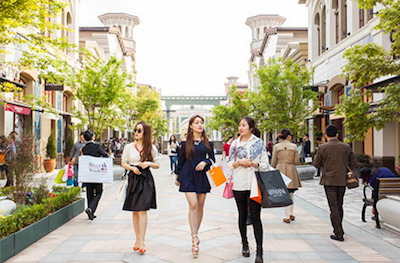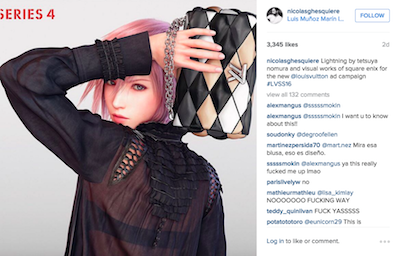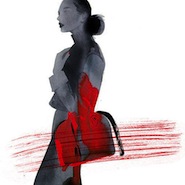In the short term, French apparel and accessories brand Louis Vuitton is on pace to have the best momentum among luxury houses during the Year of the Monkey, per Exane BNP Paribas.
Exane BNP Paribas’ “Chinese Luxury: The Year of Monkey Business” report looks at the current economic climate of China and how the slowdown is impacting luxury brands with a presence in the Mainland and Hong Kong markets. While many brands are concerned regarding the slowdown in Chinese spending, the financial firm suggests that growth for 2016 will match the year-ago.
"The macro-economic picture is not expected to improve during 2016 – this could affect middle class demand," said Luca Solca, Melania Grippo and Guido Lucarelli, analysts at Exane BNP Paribas. "It is prudent to anticipate adverse impacts on demand, this time also affecting middle class consumers.
"This is bad news, as middle class consumers have been the main driver of growth in luxury demand in the past," they said. "The political situation remains very tense and fragile."
To conduct its research for the Chinese Luxury: The Year of the Monkey Business report, Exane BNP Paribas spent two weeks in China where it met with Chinese retailers, European brands and politicians to gauge consumer demand and market stability.
Monkeying around
Chinese consumers, an integral demographic for luxury houses across sectors, have slowed their spending abroad, but have marginally increased purchasing goods at home. This shift in behavior will result in growth for 2016 that will, at best, match that seen in 2015.
Since China’s macro-economic landscape is not expected to improve this year, there could be an impact on middle class consumer demand. This will negatively affect brands in China as the middle class demographic is responsible for driving luxury demand.
In addition to decline in demand from the middle class, China’s anti-corruption policies are expected to continue. As a result, Exane BNP Paribas feels that high-end consumption has “found a bottom,” with no growth expected in the foreseeable future.

Chinese consumers
This combination of demand, anti-corruption, a cut in import duties and higher taxes has impacted Chinese consumer behavior. As such, Chinese consumers are not contributing to luxury sales abroad as they have done in the past.
While visiting China, Exane BNP Paribas visited brands for a “channel check” where they noted full price sales improvement for the fourth quarter of 2015 compared to the third quarter. In Mainland China, the fourth quarter proved negative for most luxury brands.
LVMH flagship house Louis Vuitton was among the few brands to enjoy low-single-digit positive growth. Upon inspection, the financial firm also found that its retail storefronts looked much better than they had in past years.
Overall, LVMH is confident for the year to come after a positive 2015 with the French conglomerate posting a 16 percent revenue increase from the year-ago (see story).

Louis Vuitton Series 4 campaign, as seen on Instagram
Brands sharing similar success in China include Moncler, Givenchy, Fendi, Saint Laurent and Valentino.
But, a majority of houses are struggling in China. Prada, for example, continues to be in mid-single-digit negative territory as the brand copes with issues of loss in perceived value.
Additionally, Bottega Veneta is also seeing low double negatives, but it is active in its outlet business. Bottega Veneta’s low double negatives may be attributed to the house’s product innovation shortcomings, such as a lack of limited-edition merchandise and localized goods, a trend much-appreciated by Chinese consumers.
Despite its successes in the digital space, the report also showed that Burberry is seen as “flat,” although its end-of-year numbers were positive. As with Prada, the British heritage brand has struggled recently regarding perceived value.
Surprisingly, given its aesthetic overhaul at the hands of artistic director Alessandro Michele, Italy’s Gucci is seen as “materially worse.” But, the brand is on track to benefit through its network of outlet shops, now numbering 13 in China alone.

Gucci spring/summer 2016 campaign
In the jewelry sector, an industry deeply impacted by Chinese corruption crackdowns which has decreased by an estimated 30 percent (see story), Richemont-owned Cartier has experienced a strong positive trend, likely benefitting from its price cuts. Cartier, along with Tag Heuer and Chanel, cut prices in an attempt to keep pricing consistent on an international base to encourage at-home spending in China (see story).
Slumping sales for watchmakers in particular in China and Hong Kong has put pressure on brands to upgrade distribution models and go-to-market approaches. Watchmakers owned by Richemont and Swatch traditionally saw high teens and low twenties in sales, but now that consumption has slowed this is no more.
Defining luxury
Perceived value for a luxury house is a cornerstone for success. While Burberry is in better shape than Prada, a dip in consumers' perception could have a ripple effect for the future.
As such, exclusivity and desirability go hand in hand for China’s wealthy, with the same brands ranked in the top five for both characteristics in a study by Promise Consulting and BNP Exane.
Hermès takes home top prize for exclusivity, which measures the consistent quality of goods, the brand’s prestige, the valuation of the brand’s customers and its ability to justify a high price point. Chinese consumers are generally becoming more sophisticated luxury consumers, making for tougher competition between labels for their attention and affection.
In exclusivity, Hermès indexes 162, placing it well above the average 100 of the top 15 brands. Aside from Prada, which placed fourth, the rest of the top five is dominated by French houses, with Louis Vuitton in second, Chanel following and Dior in fifth (see story).
"Exposure to LVMH could work short-term – Kering is probably going to be okay in the end, as off-price activity should support sales – Burberry’s path is confirmed as better than Prada’s – Tod’s seems to be recovering (but the cat is out of the bag on this already)," Exane BNP Paribas' analysts said.
{"ct":"tnIpi3eB+jJuugJP+dKttoj89oXgb3zRbjlG6YpCMUQc2RlCQ0CDFll0YilOoCeF7hHbZh2S2KVmDJMA63LHe93nTpiBSp0pn1lE5BfCZgxyfvJz9yQtywsphS92K\/fNoW33iXAb1vTyHBQQk0UtiP1l\/sqseN2sXtkFPeJQaKUOQusxh6m4s7PwzkuWtw8V5aIQsHmxkgBOTNVQZHizVQrqodvnwLHQKnpliqXArfmKI5RlDWrwp274tebc63OjPH\/FTvDo2NrcrbKK4yamSLmJLmpoj6XWY8SY4ow9C5L177f9xPIjw35NVmvOMM1Xv4Xh8lu7ON4nL9hJsZrFQdwSL1ueBs26LYHX3FzFlHljpMJau5Rz6erJT8jPDUP1fwppCdXyJz1lEjCyAcn+xLc\/dSbo6F3M6PsF2cfQrgb9t9xJ2M8zgJTdcW4vkeVUUWIDCTjcE9cloQDX+p4yIu\/aQjDRt3OXucpLrBRng9Z3sU9NkA2bCdKkridMrapuW2PQs+L8CdI3Vycpfs8XYRPwQ4KBCo4drJGX3EQYxVO9E9hFtycZuWnT7ETjebB\/KN84tZSPgIWPy\/Jv1IZwqTfQfeyt6RZv9ZaEidD2ekr86qtJ\/JFSg8darUiuNKUsg3IILw1BlsDjqRrNWI9GWYnLbOetPGO3xKy92H73TDv3bjKprp3SBK1pp2p1\/PDKf086rlZW+MsShyQyMWVZj9vuReMaVSXYsaaH047OBp8o6HozuZnfSMv\/FZ2j3qDZOTK5e5QysPH2oFucc2HcWFhKMhTw\/aBlCuJciNTy3SIpZvgs6zWGyIWfxVAiUTayWQSw7LcRsB10YnjXPalNmePGZBAT1a1eYqIGOXg9IAgAaIFVWDp4VLxp+zDwoUntlO4UaEfU0lW7YqoPXTDFp\/dSXaqsUp87pvBGFXzxDDD6EmiOcnP+uPPgBjlt\/gqPYFE3kDuYfSVMFxGVe512PwT+C5tzIPbRastn3q4z+O1Jv+ArvSlCx+vbO\/X1knK5U5R8WCMSAvTgfAHyBse6\/0NXQ6euaT8\/sI1h0hLsQ8Qhx+j5mWA3OZjw+3lPO8EgBlaG2ed96OkX\/dOqDslmamGOGO0eCF7vLYi82o7\/GBdeZOQNVMPm7BT7nCnd75y0nJ1INAweriBWfEjuHkpS9V3WgcrN39W2GgaHTDS6gwPkjpyS0WMu8A71W8S2JfYSQ4DAhP3T7BLdrSTvXYy9u2RQnobac4SyHxt9xDlOMBog0npkGjxFdQxx8y1ouV7CsGbDeWfvZTiQmzgub2kT0FN2Z7mMadtGkk7SBw0cmgYLRGvEmAS331lKG9kft9UNV1K5f\/vVbYthz8RCHwoIdL6kgpT5bYywlKWf7jRPrObyz+\/Df560+cjbewA0umpwVUFabumqlE4DvD7JJnmxr0TtQMRnx493tl49LaEWjcTMLBWFiwZidnQGYh6sNyQ\/REkK+ocoNu1AsGIHA+Z\/lmHyDCOpDZD7VVwgUztPr7n8J5njEz30tgryG4JsDndxS1hkoR5qK\/2hja+pSSpilELcR4Mdp6ner2iLu1O1\/neaCM+pdfZIb\/zEHs6IUAYIHWX1XfRlmzuw1q0Q5pDQbBpoD3RkHMcCBrA4EHlxQCHfb88Ic\/D0dfSuuUbOnPurqGQpBz3nNbMTZwWH+kxDOSm5zOIaiSO4y4z3BepZCHW+OOplpQrV34miEEx2JWJiihoUpwhHJiZbQZP3krMVdtwEsC8yib4mPuQmz1\/HZq7ntVDAIISERsDU8kyw8fjr2wI2Cq4dwW\/9ItyzgT93E9YjzW9NxgoY2ms8Z+V4\/L02s74II8ptk4yRgHHHGCvIXyvcFFQxoJGJMOidccJxny0uNnQjH2vIoY+9eXBNTDLdB6ePMhDWCHR0aBH71+rxOtHq6GxNOoKCLzcIEM4vUdEMzvbe5UolbCMG2cugEjRoaXPBt364HaILz5nVZAJU5Onfh\/mmvjiroouutfAbfCh6aXr1uc6p25CGCT8b9Q0JFly3KnOI86t5DUGMJeh52xx3S6KUb4oE34ZcCdBWjUezoT2m+lRKm5+ZKpFWsSCkhRP5MVqSAV0BwKZnm2m82gi9xK8Y19PXSVo1M0+BlYwSvcxUTfuXyEVBFTrmK+r\/7OxvFkj\/rggkY1le\/kzuauHuSa70acQeaonKltkgjJ++xqHis6BgIbJ6TaBuUiIJKsLP+3S6MwprW1SdFm2ekY6uVGiih+w44CYBQTp4GOVYuT2R+O8sopW5Vdwe40J6SrkdnbVreNu3JiZa5gAFsRcHih5JYuyXTELIB2kmxr3HF\/x4N\/nhsfPCa1MJHNUCc1K5lnLmFeJ2MnMaHTxCnlfyhoEnY+ieMqkz9OC41LeSHi2OA4\/qN3Qbtu+Zs\/2TqmLBrs8+UiXz4MkuB7OdXtmPIJY+Vm3twerardtzSUluiLWJ7270rOkfC0teEJ3l06z4Yl4w7Ot2p1Zd92MMZG69Y33ygr6wKKS2pixGmvQ7k3WJYxuZQYp+lJ12s2acXLQFguJ+b+KxCXjee6oW0MXHQx7WPa9811JSJWP9duNpNC9vwBKYq\/B27PGqzAFlBYxptpzk3aIYgMxpXZh5GjVs3r3AVe5Ci8oXf\/qDjbd39yBEUAz9PXDFS8ajcMro9zZdcb+9eBvOVF2EPbiZrYS230FMayDqtsiL29CwzThiDxOv+LNI7CO99gIOy4o8ihMK1\/KxjmtN6oc\/1uGYWJKAq4ay2MLCbMGVMEuDmJrZq\/nT\/RFKQsIXG9clIich9aUmrcP8OaeQD3p\/DGL\/v5aZbJzzISC5u9JxUinQLcXXqPrRlGVcXSYQlL8nS+fTyugpLuPJ6Xofz8zbGFjGya00B10EntPdy+iXuQMOywDs+TrFhaAQENJeAVVKm6qXZDTJ5Wp4ZDma+v0JfBCgsua+MW2RvOXgm2xVO2m6V+YcmCqz7nlTQnjDLLlcZWAPpQqaGBnGkbTFvA1oMAbVDJM6JZf82O80V4ExZYIy7yskOvV84LF9rjfORSeZReYmUCAMRCjOU73uoUZTpf5dNK4ghruFkTzWDSQ\/3O5R+lWVVl5a2E4XHXIqs\/4QCrOqEcEbnfqlMwO23oYZCmF8fFbB9eymXhIm6I8HtawNqCp0vTkmxDdyD2MnzgA3zQ1aUKZA6qsJuwSrt+OS3n68X1ZWe0uNE3EEwTtqFY4gtxOcTA06+ogOEi2CDSqxHhB5SddH4IMNNL8DKyG8tp0ZK0t3A58cyd0bpA9qzs7FIslB+z1SJctHWZmwG+EUjidHjnAuAUxP4n4EZ3nf38o5Ymj79VyDRSwOzGooSaBTDpefWv8Q69UTXZtU3eSFFbPrejsMhPmf0x1AlegCarADUg7Zjcn5M5DNGfggNjLYbnkZt1seZCHn3KRDjKyP1hpJW7LJi9F2kDyJlPnikpWbcPPqqy8o768pPt8woA211CHnG2\/hmD00jub8UvSfxbJnqV46\/V3Ux9FO75lM2U8R7U6Iagqyp6XIJPYR4Mj8IbiatMs9GGlLaZC6rNVd9q84CC08nSc2u\/kQ1ff5Hq0xt+j8zEbVhWMIQljhEaRNGeve1CzGbzRRXvNV8E9V+AHAtN0uf62lt0WDE6LQq7tMfPN64vIeMbTzmCLglPk99ax6NHCgpzv+weMPBUwPTXEPHqLA5ZkNBj8dOykGkJwpLqK4fJsBztmeoVUN6vazuhe1iXt5ALuK6jpDEUpL+HdVfb26POgc4xWDYKS9FUM8hArZDfmdZBm0OEkIPKv7q00lxBZiqRmZ+AO7hAXBMHyJSlgP3UgTic0Yb7UK+cy8+EFhv6BN\/pLHTFHnDRrqDk00g8xvePbfgZN3c\/9SuCLF99BSU5cak\/I2YRyNHS2q73S1gGWl9Y9uXhPjNA\/PeoWcUyk41g+oxfW2pHI5CV78v1EGvUWrHJj9ZBbtdqtXO2I5u4qOs8XINcYvN3F8EKQooJzHgErUvkc9RJuKZTxau96zxz6mTho\/rD2WKe\/AQ3lgF\/P1yuQsv9zTR26fz+Rv+cSTWXu6xm7Lifj9W2z0LUAjAeBnSI5A++m\/CTIcvhCzPNHNEzF5RQ0K62QdDYfJiat3nqwsrp6zaT+gRnkydKvM5gGvc1Hv44PEvkozDvAt7qkP0QcuMxwjgM5nQZcsXt3jPl9nqcaQK\/6OAfzpG3\/gehk9Yb48bF91sX6F0IIjWEwP3oV38E1yXbpDCiyyR9GNhdy6V3MOIfifTVlJn5Jq+VVlJFm1eDaVMMbLz9groNqPEzA67sTn5v1\/V6+tWtlyVTVSByz9xHqCLF161xm8oioC47rRLJTPxO23b6OLi3cSwG4h4z71qw49AmjVCteRGXzr2lb9O\/1Hlzp6GIrT1SBU7q\/fc2izaog5MOLH1CflNY5d7VRS8eRd91PsUXWrFYVxP\/oGdg1WWGr6I5k9zIwhxMKq3bJSUu2jUhmC7hpvlrNB7Vvt+GzmQrpZh+MXmMO042nPsBGspQBrqJixGbjy5lgyKR1vOvY6YjENHwsbXwDzVKxGG8eLa7D+ytS+Z5Aik1TDJLjPfMD5eUpldeGqFPjMy1MrVrsiR8j8EcQTS2aImEfuGsQMC57EcpX+8MJ+CCz\/Ba65pJI0xUbkDvYhmfJgtny\/VQQeG4h6Y1EJVcbgTra0eDhqW\/Q8DDxQV8wT+lYQfBKlJbFsshDNbyhSVjhlwXvH7SpZ1quPVTKQsTLJ4bBFcLd+N9AUnDo3jaJun26YBM\/LiKKtzt5oq6VoMptRI+xLDAX8JETgprKP9PYedTMrSbeXPaPkF0L7eVdxeLkax9Ughl7Z3D7UWqddmEomr05+cCjmPUHOITv5GuE7PIPHrKPvwvfnnQCAM4cLEmq3mNC7Et\/xDpc5RmQAhjtJ8cpp9LLAhODnCh11NbvbAVbpniRbBQOUWg7UspcGg0FaaUzWUtJ0t4\/l3B+agYqJWaPj59CTWTGglpIc4006ab7s8gSksOGVBl3U19p4AXjj4kleww70FxVaxJW\/YluzytqRmvM\/DbHPdy+4AyKdmd6+o2Om0FDnmRqEXG\/5DI2w92TMhBvx51Gll8rQLs+WpvkKREB4VtPmQZmwgxE2hb6+\/M6ZLKAj2\/Y5PTKrS8HfppytStJM9VLvykZGSMlyRYuYtircvrwQTxe3HMW6c71+MRLRo3KmGde1yOMS1w5K37oWvbqSsZETR22rI6HH44pG03llO\/hMGDaxTrZgZtpNqd8voBGsGbz2\/2UsHwHdFSHmO9VTl82fffKsR4xkpNbnrW96N+aHjLtNvItEnlUqt6mGOX83PozseZ6iwW2DE4G9bBbDraq7DwrAdJFXYmRMsZhOGhQYCctl\/5pzeQzMUjIPDwnq4UDFEIr5yOtW+7XWwCNcJl755NZ2fibP3pPGcsy1tQi16MRrlYE+TXc0lCUk\/bJWPGrXsX8GFDz1nOH27tCpsGGFs1CutSQMqqfZ9bACfRCCgUGnen9h3tYfAkFy1L5tyJ6KhKAfViGi0aPD0fcEIJsi0rf3CyYgjwLG9D0LwdePQx99UM7F+ZoFpy1R+s\/DeTr6oyq8iCx1McHfmaH46u0sL2KzbByXRk\/NgW410LPpspLDgqLmAVYoFgGIXvCzjfJShogWBmX\/vvddww7wj3zwcEuz+T4mw35FnsdZp+lZpJnRgYT3S7kL37ro9kRZgGTSRvusqf37MSJGs6fHZb8uF7GaBX1tA6\/DMQ0FkhhkDcSqvXSkwbdKtSYph7b9aNqtysUwrgpgNj3x9c5QwGDEY70RlQg5sHm157JBFj1e8gTGzWtmQsAiLWSScUiONpUm3Q9DWunLeQ+qaK6vXFcwa2M7XyaJvU9glVzTIZM4AdQCLSV6cH4EqzEh5h2VvIZEIZFlZmGjxSXYKralW\/Dp+XpwnBTTSePzCQT\/pv2HpS48Z\/1ppFYeOyUxw9CBcl+FTkwXiC3ah5FL5IhTAkYWc1W24bnAjb7wCNu2cKXd96Goyu592l4f+mT2uiib58GxWoq5rZC5eHgeus2PfE93KChqwUA8inuhXEkkDzCKSbH2sw3bJzS2TcX98mo58wXg1nvhbN3kfgo997RxqfVZ3b4h+BXs2s+2qm0PJAekO0PBUrxZhx4c7zuvtMnBqwcxE9inVc+PLLgZuO0wvnZmoV\/h+1rw5n8L8wp9RIaL4v2nZS+TazaNm5psVBzcGAQ51ClKaCWezC5os04qyXxYHtQIseGs8zQpLeT2tFPspFtIpvhHkvpn\/UpR9fP5k9G3J3a65Z83lgoi5Xc\/gxOg5JtLyaUAKTI7uyvoIN88916coN1e4EdA0meqI6rTOzozFgfjXD3yVie5De2n6LcAo9gguRdN31yAZNqpkUEkDslMjpJbX1VO\/HRVodsXRoO2KHwE4ilnhlrZHLJQes3swic+kf5KLuU29nWzCFKIVSsgfNKZF7IZNy9u7CwfYdi1nNr1SpciUKJ0JSoME2ZqPv8\/o6vRkJqWlYy0yoac6W+iHv2KvFS0X0xgZIk+mKM02d810Z5YeuZDTTMf0v22qlyofyq4WX6l8cL6NmoVqVzpuQQZ6cASxtkZuXAqG1Wf9DowZhrMaEAKfShJb1IuE8awgOwWQl3Z3w\/UUJC1pj12+uRmIVN6h3tic0+Aee5byDplM1b+BjP4meNMErc27dS0Y+\/LobX0j7s0gNk8+ZQ7G6Mq+9eQr2aRBx1K2eroQq9gx466UGYI8Eht2\/aBVlPmzA3lXR95dfXQGPDuTi+jlb33vHnzmVFNhKo6IzDmrBSWzBkqqr\/Nco5YhnCJAhkxI7TL8m6X044BcQEC9J4hVHMCrUJHLNfw7d80pX0loPuJKaNqWFUp0aor3bmh7gJQJRo3meEtNvxyJtjRUY9zR4NsCU8ivllqVlzNFP\/fN4k66W0j\/uRpGkeFRuPAg3nQ9VRaT+RhXrBoEhQr6vbB2N7EQcp5JojTGWM4e7LWDgaH6lkPA6cDLrXcqruWGCJpIOiqBqoANU5qmTllKV6bAqAtSEsnGvMSTPtDZzt41ckMTIhvGRrfiwMtDgsCG++jGiAX4m9inm10PTCdTlbkrwFMFZCkiBUGM5qDhCMyR7bPQYv4UEpsliH3Y5Hf3D4INJ8kJNPaxWRKNY8Vhu3T2ozQYZfdCZe1YciI+2plXNG\/4EuFYccNisa7qxWpNgbLjZM4vvZkP24K7arsRNMdzHg1hU8k7RX9KAJ1HrY7ZZCqp1+bjbnX7g9TCOdSxbC1NsX8l5gWH4BLzglkQCEUaMtZDKq7D7\/+raW3nTHv+tpHgJByUJ8+AHwrL8ga9tzPfCyc+oMCE0K3TzDGT64PnVcjvKnwzHsm0z8CrefA\/MFD3PEe4NVlgrCzUXybuKG5krMHl+vNIZMlGGY0kUgMCJMOW\/37JXw62r8Q8425JRtuYm1pHb2Dyb25QJAAiQi0Qrn82goKg3MiExDtUKnsemeCpcoDvNZGGIS1DvxOkrjt6s2ZUl4JiDqohjX\/gdFZbtAVbhNGnogHCxDA22kFphMDrNLpWe9bWpcsqqYwLtV2iNwLhMu6rPSVQOaBTYMBbCyuognNbDZnF3CWEMFQcVlPBJNws5t09B77NRi2qUnQXBzJ8vUrcK+p2YH7RHX33cyZGRysOqB\/pcEgahqW2VoR\/G3+aqZIibnyLnCiolkbgWTV5p9TBfPhIitkFtCQM\/bFC8cbMmW6zP3eZ87KAS+3qIsRpixvkX5n313PDl1quQw+f1stbyglxrWSZRVeo07nEjEjpyfBpctAeo+OFj4FsWtREaw28lzcTrmsuD2pCGGRjpuShIkax4dpN7QBr\/ruR4YkB6ZHQ3n4fLB74V9P3p1a6WBgqJpZjTQQIbMF0+tsqPxN56y2L3EqFDdiMH8d8J4sL+TAeSDHywe8S+eFmDrnXAoq83nqlDsSE9\/hzN\/MZLLkRANJli7PRDj9S7f2NxeZ5+nY1QhYusTk3cqHkakvOpXcwSYPReTbQG3zme8O7KcN6e\/\/Qd+FeuEI1ISMhhN+K1NxkzXmOGJDuiwtA+kis8Xu0RzQYogu1qLaZm9tDiggrf1niTxOvkdaTJXtLNTZQVS+aFLeacmFlV3gQY\/Yw1t7wjxk+7iSBismMVhmo3ZCJFxb2RDuhre\/\/SsRm5aNnFHeyfG0wpDhjeazJUvW\/v1um75zal43dqFTfg\/v3rvDY4aNa1vtYlyR8aMc904Fj9rcZwMZp2keVQrlsVlBFCYsW+A12D40HAEQESUdEe44xvKA0xeV6+TSy\/9e1c1Zx+0\/f5auIM51zIYDsVmHAbNKuBSAuSpTJfTyAC4zG1Oy5pFi7WP+ra64GEVqlakOwzEHSuqMqUOo3tY0NxtfRasPbR29vVomLogvoa20XPWgrk9PtPEkeDt9AnOuNQ1uBgvv212RFoa718krS5jePRCrVVqIJi4tQacODe+vY5TTaORyYiISlkhdDhIXqnmUUcvhdcHE6YI5uS2X4RLUQQ\/RMRMNYD8yJNbbcNL4qYaJ0G8F\/CSeM\/jfJCQk+6Yh1qLJG392+xu\/rfnGkWcYJcipeSXaQtOUPZM+0b1TSFA5BF6234kJQkx\/aUyRlRxs2RB67Bn\/1Q5lunw+P5RJFQI2+n+UEkJCbSVxoVsvlK08NuRDzyT+W2KPVSVMHAyqGIKEnEbv7f1Est2hR\/tcJ8xNTLJprPLrTlLVKWRBUp9LAvDjUjgyk\/5VlDkYhAHgHqSever2g\/gIjAMUGLlJbtdyxX\/atdDi7F93CTH+btdLHfg6CNduzXr7CasUX\/G20VbkOb5Epyf2JQGcKGYBtKudcBJ2i6BPa6rB0Ma3SNKmwt6ui2i+gQyp3LStGakCLkBZx1vsoluYviisxv7qxUCCNpftoGYymzXLkZ3eRXUUjVU\/cvv7v+6UaIS55Ucxg1zsRA+qtGPWKpmdHi6JFC8vcWckF0HU\/Jq9cn6PGRoFaPFiXCb9poGlBJHsNQd2yN6qrYAqFVKNvjURDOik+s32kK1GbGxMlJO6nyF7ZlIODNQqUYTd4EhhPWhdiKMjrvFaW\/6axmqgivck8WK5rpLA0d9dJU3qqWODxgk27T8Jh0e8oo6vOhVzvaMPsdfoLOUezq2m5k6C8FRNL4Fc3WB694\/51dydbBa7brDLIrQkRYhWDfCfQv3DymwSClJ8EyvItwKtYZJGog93JPY2Zz0qhbPVDTUz3ptEyVs8e1N8WEJJ\/bvKarBXAcd1N605xQ\/YpioeVCVXCat4ockg5Yr+6sqEmfjbDrTkf1\/UNaaRtZJVu54g1Bj9CdUsq99XEDp58tty20p+Ae2fBVTVNGyZ69fZy2CKSm03y4fdjh9jgH8Oa7ywqlQzMjisZnJCmefl6MVxccWdOMxeaqcjPq7E8HuD8fjY9KO5w0Fw80SEWBNUzpvL5GW4ltAccegWoOdMjg2LkpzLKdijYgmDg0dGaSdvD6GMPsyOAuf1X2ikhBFhn+SRAbIGIVScySEbtzKO0YSY1xUq8sW8YOELBtU5e1Sjx2iwR3FfZjC2H4db6OJ2mehzGYbzLirqm1lkBofdZvGRjzTfiEcl7VFC7k35JGMd4E8tKCbm9Pys51fCsqxw\/eI2ghSnoh0zf1B\/XMOy10sDF11B7zj0ifHMZTf9yiHjoB1v\/U77x+1tt6MCAfrH1TaAD6PBWrHdKycpPnLoNg1cD9XYyGOUItjJf\/t7ijrOXkJ0nlucw4B3rEB2glPxwcbqXpRfFnGUpGlKWMNnJda9GjqPhwGvtbYilOJ1VOmHwdV\/DZeBp8wjzDqXPT+61mZWI7wDqGB3iWSlCd1APyyapMsofk21+\/cbfUBl4oUXzwCONYq7wX1WW\/sJpD3f8bqxAa2tARR9+O7FqcRzUiq+EfhIvUiMXo\/KeBAiAXmWEA8e2Za0tWH1ER0IdsX7APSO2Rczi1GqqTpVdhaHpl55KxEcR3pfpTzn0D1V0AKeZKjmAqZxtrMGbjfK\/KpCqUnE+TutTF8jK6Nv2E0s3FQDdWv1jQbFgC7mB0RJJr2nSiGcEB9ubocrNTPATg3ZjdPPBCrLOtlQg5hQH5ilOQ+WN+2aSD++QK2i3KIwLgMeWQEnJu1xRGKXa6jvai1iL8Lg4TxdMnfe74LGzoIBvOaHmeHk5\/0IbKwijRnLeEFMJqv4dSY8QDsDrqpfzaj5r2T7zhPC\/JHvUTTiZ8of8LmC2SNqYMr6JQWzwz7CROPx16MNCb3s72dYgWfHRbZ+YIyGy1VZ81jAuP\/deG5vfMXxxpprD6MBNzSEqeAy8cywkvK3vyZyOOq0rRvFqFCtp\/GFmRSw53YRDgomev9cs4v+tlWv9wMc5ULYSq97cM3Bgs9QvBwaaX8AF0en8iziaBgn6UCOzwxgMC76F9LG\/Rv9ooCc6Xoqefo36icNExeDN4123yk1lXd+z8\/PFaZhujgx6v6RVNwr96\/3sSQ5UxGL8BAKAP42lAwCMgv6LlB5msfMfW6yQH\/8ppFhZ0D07C\/LToWCSdEyLcBcgJjCoPZo5WYO2tmK5XKw4UrkWKQhGHuoXVbcKwG4\/eDsMn4AyHsauSBAWS\/EKrnkYaeupva7AQq23oeJJ4BuA+ZBfUItN0XMJLWk5kENjGlBTrmC7dmM+WqWOBhTIEMwO6ejeObFJsXbs6cypYZujM1bexrNVxOq2yGonc6vz6i6uFi37zWH5CIGmg6ko5nH1RD9tpcygj88jCPE4sqD0pCJbeqnVPiYwp8zbH\/lHbw2KJV70YOpCb+CgkoSP3iUtVouf7OeS5cSiCgGxLypDVLa5C4BDUy1jM9zS9R4Vg6loHH5Ub0Nt56AclL\/bnOeZKNAYR69fN9FU4tPiMcBDdJdfOapdr1HjVspSJ7qR6Ow3uttpsXWW8ErEpkrfyM5PRVvC7a\/l2GV\/12LH6kApN0\/Fbz6IbrNe\/xGNDwh6sFzrX0UoTLTR1ZTbVC3oPFaT1iilRrn2Lj\/vpXFl0anw+nSZUW4UhtPaEfIErBD4l\/RPrzlC02kDDVWNgG6CCSJb2oUCL0L3nsle3mk7b4zJoQS9DxnZAIMQEEnqWbVQnMmN9hJd5FCw9NtJLCPWFW34siujq061If0nHKcxFIlzNtjhw==","iv":"26891c3f6047c94c310ab706537c8bc2","s":"60b961a0e3cbb1db"}
